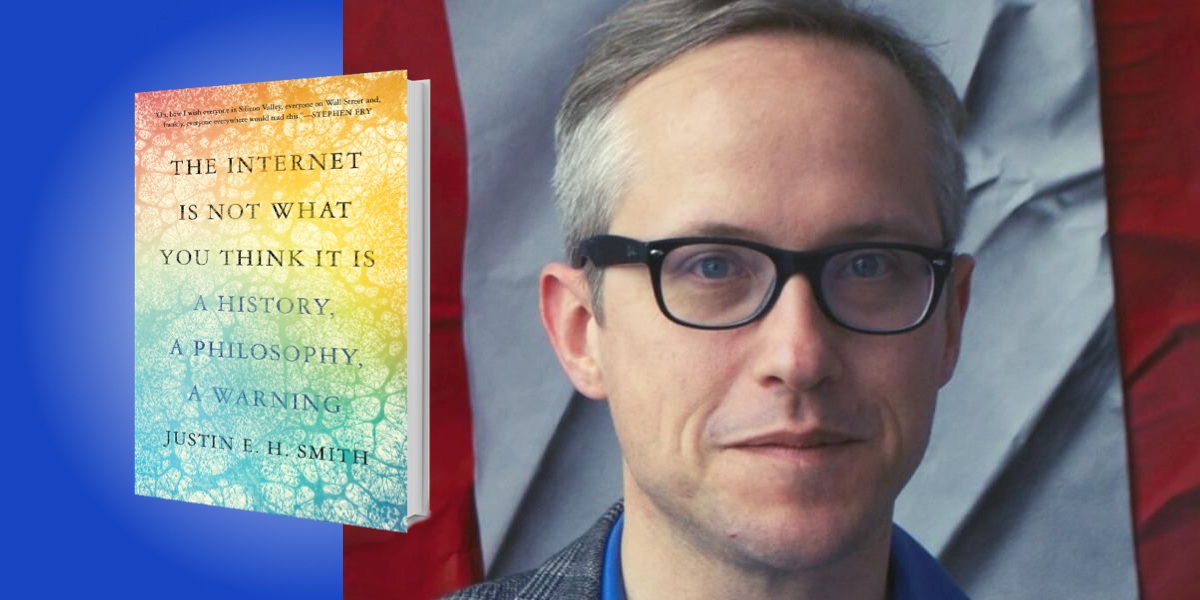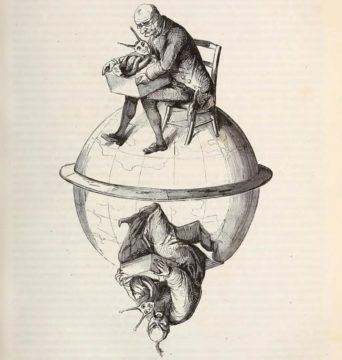by Charlie Huenemann
 Justin E. H. Smith’s recent book, The Internet Is Not What You Think It Is: A History, A Philosophy, A Warning (Princeton UP 2022) has received plenty of notice here on 3 Quarks Daily, and for good reason. Smith’s books and essays always remind us that, no matter how bizarre and ironic some recent damn thing is, we are always part of a long anthropological history of bizarre irony, and indeed the harder you look the more bizarre and ironic it all gets. At least, I think that is one of the main vibes of 3QD: seeing where we are in some map of the strange natural/cultural universe.
Justin E. H. Smith’s recent book, The Internet Is Not What You Think It Is: A History, A Philosophy, A Warning (Princeton UP 2022) has received plenty of notice here on 3 Quarks Daily, and for good reason. Smith’s books and essays always remind us that, no matter how bizarre and ironic some recent damn thing is, we are always part of a long anthropological history of bizarre irony, and indeed the harder you look the more bizarre and ironic it all gets. At least, I think that is one of the main vibes of 3QD: seeing where we are in some map of the strange natural/cultural universe.
There are plenty of books complaining about the evils of the internet, and to be sure Smith offers four complaints: it is addictive, it warps human lives through algorithms, it is ruled by corporate interests, and it serves as a universal surveillance device. There is enough evidence, both objective and anecdotal, that too much time on the internet turns one’s brain into a Twitter slushie that leaves one in no condition to meditate upon difficult problems, but instead only to scroll and click and scroll and click at digital gewgaws, feeling empty and alone, a terrible feeling one then tries to escape with more scrolling and clicking.
Moreover, all this clicking and scrolling is not merely worthless distraction, but serves corporations that fatten themselves on our data. Smith shares the term “data cow,” and we need only to read it to imagine an industrial dairy production facility in which humans are milked for their attention, our children wailing in the distance. The genius of The Matrix was to depict this grim fact with brutal clarity: you are a battery powering an information economy that runs on you as raw supply. Sure, you get tasty illusions as recompense, and have fun with that.
So, yeah: we are some distance from Mark Zuckerberg’s promise “to strengthen our social fabric and bring the world closer together.” But if we can tear ourselves away from the hype and hysteria that passes for online culture, and stretch out our historico-philosophical telescopes, there really are some interesting things about the broader range of communicating through networks, and that’s really what Smith’s book is about.
The philosopher Gottfried Wilhelm Leibniz is a recurring character in the book since his metaphysical vision is something like what the internet is supposed to be. When he wasn’t arguing with Newton over who discovered calculus, Leibniz was arguing with him over the nature of space. Newton thought space was a standalone boxy thing in which bodies move, but Leibniz thought it was more like cyberspace, in which each site’s location is determined by its links to other sites. Space is relational, in other words, and it ain’t nothing without the stuff “in” it. Moreover, Leibniz was nothing if not a facilitator of early modern chatrooms, working tirelessly to form scientific communities through which ideas could be shared across national boundaries. (At the same time he was busily stealing ideas and promoting himself, but that’s another story. Silicon Valley is Leibniz minus a big wig.)
Leibniz’s own mature metaphysics was seemingly built as a metaphor for the internet (or is the internet a metaphor for it?), with individuals harboring their own representations of the universe, changing in sync with everyone else’s representations, all coordinated before time began by an omnipotent and benevolent entity who knew this was the only way reality could work. Smith quotes Michel Serres’ observation that the internet “really is Leibniz minus God,” meaning that it is a monadology of users and servers without anyone in charge.
Leibniz was part of a long tradition of neoplatonic philosophers and mystics who believed in a grand harmony pervading all things, a cosmic “natural sympathy” that is something like the World Wide Web Consortium. “As above, so below” was (and is) these people’s slogan, by which they mean that what is found in the large can be found as well in the small—perhaps even in your own soul. The connection among individuals to the wider Great Big Individual is not through mechanical pushes and pulls, but through some spooky action at a distance, which today we call “wi-fi.”

Stepping down a rung from the grand harmony of the cosmos, Smith also describes the wireless connections found in the natural world, from stomping elephants and clicking sperm whales to moths and networks of plants. Over several centuries the information sharing capacities of nature have lured many of us into the hope that nature knows special ways to harmonize itself, even as humanity fails to do so. Smith offers an amusing story of a man who tried to make a buck from this idea: “In the middle of the nineteenth century a French anarchist and con man by the name of Jules Allix managed to convince at least a handful of Parisians that he had invented a “snail telegraph,” that is, a device that would communicate with another paired device at a great distance thanks to the power of what Allix called “escargotic commotion.”” The snails formed an unbreakable bond with one another once they copulated (or so Allix claimed), so poking at one caused the other to move, resulting in instantaneous snail mail technology.
(I know, the story seems too good to be true, and it took some effort to convince myself that Smith hadn’t made the whole thing up and corrupted the relevant Wikipedia entries.)
After some discussion of the marvelous ways plants have of communicating with one another, Smith cautiously serves up the observation that “like a network of roots laced with fungal filaments, like a field of grass, the internet, too, is a growth, an outgrowth, an excrescence of the species-specific activity of Homo sapiens.” And later: “The ecology of the internet, on this line of thinking, is only one more recent layer of the ecology of the planet as a whole, which overlays networks upon networks.” (I just accidentally typed “newtworks,” which sent me off dreaming of a possible con scheme in the fashion of Jules Allix.) The point is that the internet is not as newfangled nor as artificial as perhaps we think it is, at least if we consider the long history of organisms finding clever ways to share information.
Of course, the really cool thing is that we can learn much more about all of this stuff precisely through the internet we denounced at the start. Wikipedia, for my money, is the greatest thing humanity has yet done, and Smith himself admits that the internet and Wikipedia provided crucial support and joyous distraction when he was writing this book and while navigating his way through COVID-19 quarantine. We can do what we can to circumvent our cybernetic dystopic times, if only we muster up some discipline and remind ourselves of what is really worth our attention.
